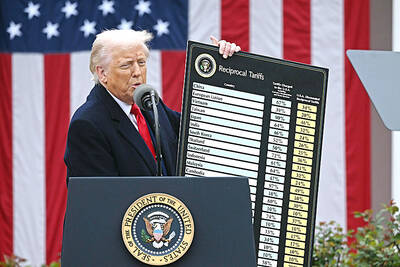Tattooed hands used to be how Paiwan and Rukai women showed their nobility, how much they were liked and their purity. During the Japanese era, however, the tradition was looked down upon, fines were issued and it was forbidden. It became very rare that women wanted to have their hands covered with beautiful tattoos. The old tradition now lives on in only three old women in the Nanhui tribe of the eastern Paiwan, and this is cause of concern for old tribal culture.
Kao Cheng-chih, a Paiwan tribal chief and director of the Paiwan health center in Chinfeng Township, Taitung County, has studied the hand tattoo tradition. He says hand tattoos are a Paiwan and Rukai sign of nobility and privilege, and that it was restricted to daughters of tribal chiefs and nobility. Any common tribal member who wanted to gain this right had to pay a high price and also invite all tribal members to a banquet to gain their approval. The tattoos, however, would still be different from the nobility’s.
The pain suffered by the girls during the tattooing highlights their nobility and honor, and it also emphasizes their pre-marriage purity and their ability to work hard and suffer hardship after getting married. In addition, the girls also hoped it would improve their marriage prospects. Kao says the process involves many taboos. Before it begins, the shaman must pray for luck and ask for the gods’ blessing. Pregnant women are not allowed to watch the ritual, and anyone present is not allowed to sneeze or pass wind. If any of the taboos are broken, the ritual must come to a temporary stop and another day will have to be chosen for its continuation.
“Clothes can be changed and you may die, but hand tattoos stay with you for a lifetime and even in death.” Ninety-six-year old Wen Chin-niao is the oldest member of the Baomuli tribe in Chenghsing Township and the only one there with tattooed hands. The beautiful tattoos were given to her when she was married into the Baomuli clan at age 14 because, following tradition, her parents wanted to congratulate her on reaching adulthood.
Although the tattoos on the back of her hands have faded with time, Wen still clearly remembers the pain and the significance of the tattoo. Lightly stroking the back of her hands, she says it was a painful procedure. She recalls that the needle was made from thorns off the trunk of an orange tree and that the tattoo was made by hitting on the needle with a wooden club. The blood was then wiped off the hand, and soot from the bottom of a pot was spread over the tattoo. The whole process took two days, and it then took more than two weeks for the swollen hands to return to normal.
Wen says the tattoos are the mark of a chieftain, and that in the past, all young girls had to have their hands tattooed. The shaman making the tattoo would apply different patterns depending on the girl’s background. Hand tattoos are a witness to tradition and history. These tattoos have followed Wen through her long life, and although they have faded over time, they remain her most beautiful memory.
(LIBERTY TIMES, TRANSLATED BY PERRY SVENSSON)
紋手是古時排灣、魯凱族婦女展現貴族位階、受寵地位及貞潔的最美象徵,但日治時代被日本人刻意醜化、歧視處罰而禁止後,即少有婦女願意在手背紋上這美麗的印記,目前東排灣南迴各部落僅剩三名年老婦人仍保有這項傳統,舊部落文化式微令人憂心。
對紋手傳統有深入研究的金峰鄉排灣族籍衛生所主任、介達「卡拉達蘭」部落頭目高正治表示,紋手是排灣、魯凱兩族群貴族特權的展現,只有頭目與貴族少女才能擁有這項權利,若平民階層欲交換此權,必須付出珍寶作代價,並宴請所有族人博取認同,但刺紋仍與貴族有所區別。
少女忍痛紋手,除為彰顯尊貴與榮耀,強調婚前純潔、婚後勤勞肯吃苦的表徵,她們也希望藉此獲得美滿姻緣,嫁個好兒郎。高正治說,紋手過程禁忌多,行儀前施術者必須先向神靈祈福求庇佑,才得以開始刺紋,且施術過程不得有孕婦旁觀,在場者也不能打噴嚏與放屁,只要觸犯任何一項,儀式就必須暫停擇日再行。
「衣服隨時都可以替換,死了也帶不走,但紋手卻會伴隨一輩子,就算死了也一樣。」高齡九十六歲的溫金鳥是正興村包慕里部落最年長、也是部落裡唯一紋手的老人,這個美麗的印記,是她在十四歲嫁入包慕里家族前,父母為了祝福她長大成人而依傳統行術。
雖然隨著時光的消逝,手背上圖文已漸趨模糊,但紋手時的錐心刺痛及代表意涵,溫金鳥至今仍能清楚感受,她輕輕的撫摸手背說,紋手過程相當疼痛,她記得當時是以橘子樹幹上的刺綑綁成刺針,再以木棒在手背上敲打刺紋,接著擦拭手背上的流血,最後塗抹上鍋底黑灰,前後花費兩天的光景才完成,兩隻手腫了半個多月才恢復。
溫金鳥說,紋手是頭目的記號,古時未婚少女都必須依傳統紋手,而施術巫師會以少女身分背景,給予不同紋案。紋手是一種傳統、一種歷史見證,這個烙印已陪著她走過漫漫歲月,雖已漸趨模糊,卻是她今生最美的一段紀念。(自由時報記者陳賢義)

A: Although the scandalous Eastern superstar Kim Soo-hyun canceled his visit, Western superstar Andrea Bocelli is visiting Taiwan over the long weekend. B: Yup, the blind tenor will become the first Western artist to hold a concert at the Taipei Dome tonight. A: Pop diva Celine Dion even praised him: “If god would have a singing voice, he would sound a lot like Andrea Bocelli.” B: I love their duet, “The Prayer.” I even played the song at my sister’s wedding for the newlyweds. A: Two Taiwanese singers, A-mei and A-lin, sang with Bocelli before. It would be great

A: The four-day long weekend for Tomb-sweeping Day begins today. Are you going south to sweep tombs this weekend? B: I went south early last weekend, so I could attend South Korean actor Kim Soo-hyun’s show at the Kaohsiung Sakura Festival, but he canceled his visit after a scandal broke out. A: The late actress Kim Sae-ron’s family accused him of dating her since she was a minor, at just 15 years old. Fans are shocked. B: Didn’t the media report that the age of consent in South Korea used to be 13? Technically, he didn’t break the law. A:

The Federal Communications Commission (FCC) has announced new regulations requiring that all mobile phones sold in the United States be compatible with hearing aids. These rules aim to expand the range of options available to individuals with hearing loss, enabling them to choose devices that best suit their needs. The new plan includes requirements for universal Bluetooth connectivity. This means mobile phone manufacturers cannot limit their phones to interact only with specific devices. The rules also establish volume control standards to guarantee clear audio for hearing aid users. This will allow them to increase the volume without distortion. The

US President Donald Trump is taking a blowtorch to the rules that have governed world trade for decades. The “reciprocal’’ tariffs that he announced Wednesday last week are likely to create chaos for global businesses and conflict with America’s allies and adversaries alike. Since the 1960s, tariffs — or import taxes — have emerged from negotiations between dozens of countries. Trump wants to seize the process. “Obviously, it disrupts the way that things have been done for a very long time,’’ said Richard Mojica, a trade attorney at Miller & Chevalier. “Trump is throwing that out the window ... Clearly this is